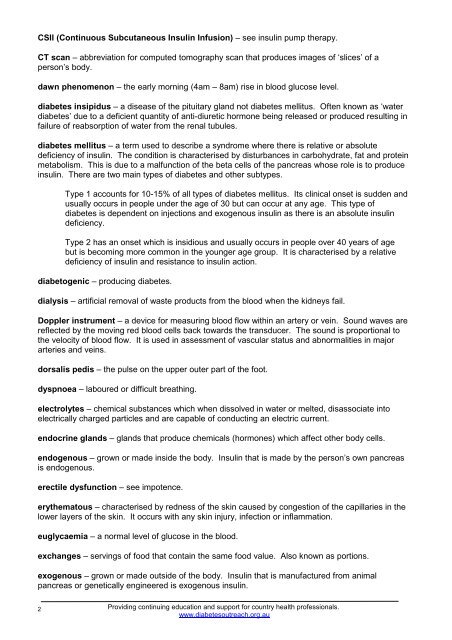Diabetes Dictionary - Diabetes Outreach
Diabetes Dictionary - Diabetes Outreach
Diabetes Dictionary - Diabetes Outreach
You also want an ePaper? Increase the reach of your titles
YUMPU automatically turns print PDFs into web optimized ePapers that Google loves.
CSII (Continuous Subcutaneous Insulin Infusion) – see insulin pump therapy.<br />
CT scan – abbreviation for computed tomography scan that produces images of ‘slices’ of a<br />
person’s body.<br />
dawn phenomenon – the early morning (4am – 8am) rise in blood glucose level.<br />
diabetes insipidus – a disease of the pituitary gland not diabetes mellitus. Often known as ‘water<br />
diabetes’ due to a deficient quantity of anti-diuretic hormone being released or produced resulting in<br />
failure of reabsorption of water from the renal tubules.<br />
diabetes mellitus – a term used to describe a syndrome where there is relative or absolute<br />
deficiency of insulin. The condition is characterised by disturbances in carbohydrate, fat and protein<br />
metabolism. This is due to a malfunction of the beta cells of the pancreas whose role is to produce<br />
insulin. There are two main types of diabetes and other subtypes.<br />
Type 1 accounts for 10-15% of all types of diabetes mellitus. Its clinical onset is sudden and<br />
usually occurs in people under the age of 30 but can occur at any age. This type of<br />
diabetes is dependent on injections and exogenous insulin as there is an absolute insulin<br />
deficiency.<br />
Type 2 has an onset which is insidious and usually occurs in people over 40 years of age<br />
but is becoming more common in the younger age group. It is characterised by a relative<br />
deficiency of insulin and resistance to insulin action.<br />
diabetogenic – producing diabetes.<br />
dialysis – artificial removal of waste products from the blood when the kidneys fail.<br />
Doppler instrument – a device for measuring blood flow within an artery or vein. Sound waves are<br />
reflected by the moving red blood cells back towards the transducer. The sound is proportional to<br />
the velocity of blood flow. It is used in assessment of vascular status and abnormalities in major<br />
arteries and veins.<br />
dorsalis pedis – the pulse on the upper outer part of the foot.<br />
dyspnoea – laboured or difficult breathing.<br />
electrolytes – chemical substances which when dissolved in water or melted, disassociate into<br />
electrically charged particles and are capable of conducting an electric current.<br />
endocrine glands – glands that produce chemicals (hormones) which affect other body cells.<br />
endogenous – grown or made inside the body. Insulin that is made by the person’s own pancreas<br />
is endogenous.<br />
erectile dysfunction – see impotence.<br />
erythematous – characterised by redness of the skin caused by congestion of the capillaries in the<br />
lower layers of the skin. It occurs with any skin injury, infection or inflammation.<br />
euglycaemia – a normal level of glucose in the blood.<br />
exchanges – servings of food that contain the same food value. Also known as portions.<br />
exogenous – grown or made outside of the body. Insulin that is manufactured from animal<br />
pancreas or genetically engineered is exogenous insulin.<br />
2<br />
Providing continuing education and support for country health professionals.<br />
www.diabetesoutreach.org.au











